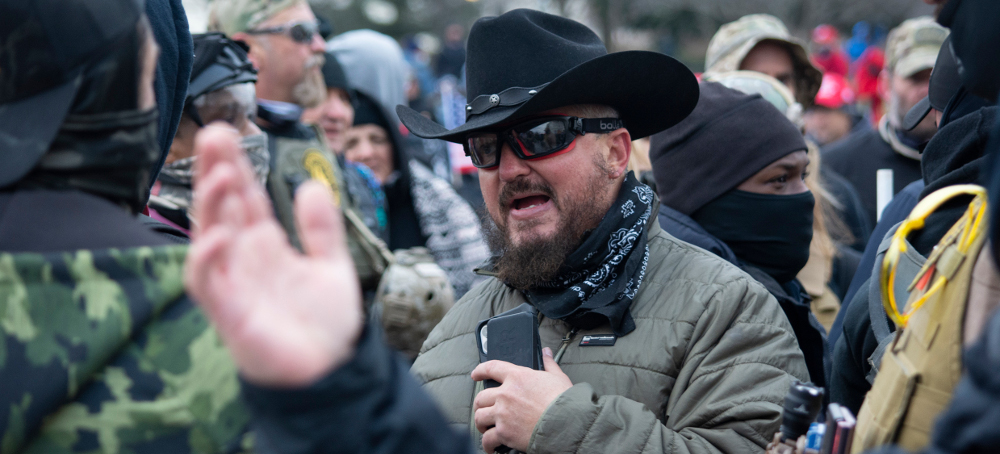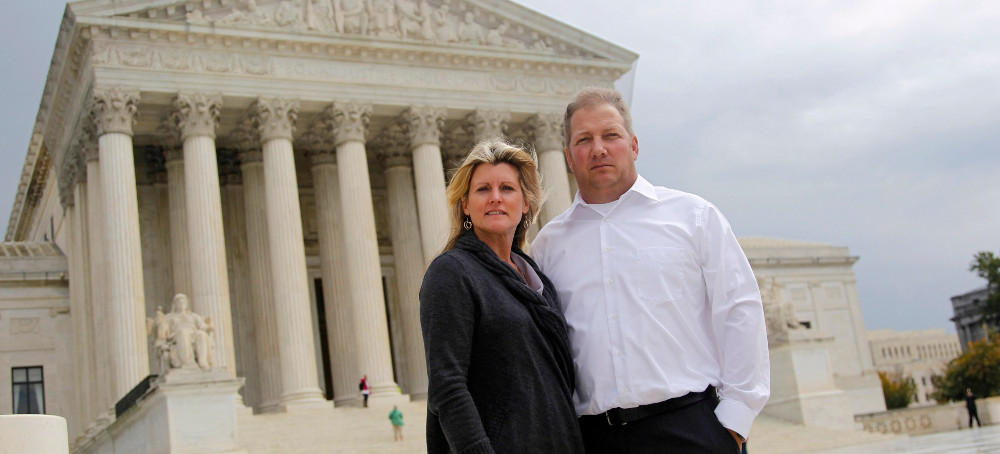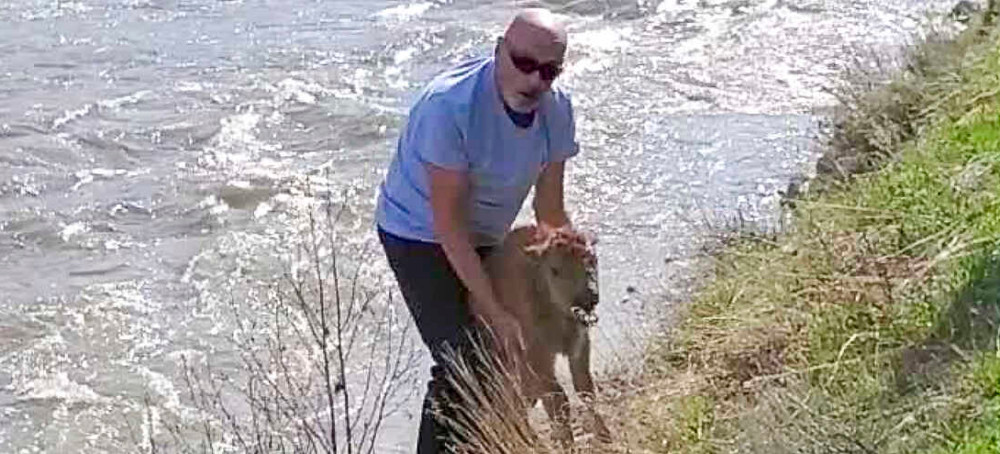Live on the homepage now!
Reader Supported News

Andy Borowitz | Desantis Hopes to Seem Like Normal Person by Appearing Next to Elon Musk
Andy Borowitz, The New Yorker
Borowitz writes: "Ron DeSantis is hoping to seem like a normal person by appearing next to Elon Musk, the Governor's campaign has confirmed."
READ MORE  Stewart Rhodes at the Capitol on Jan. 6, 2021. (photo: Ford Fischer/News2Share)
Stewart Rhodes at the Capitol on Jan. 6, 2021. (photo: Ford Fischer/News2Share)
Stewart Rhodes, who said after the Capitol attack that the rioters “should have brought rifles," received the longest sentence of any Jan. 6 defendant to date.
The sentence for Stewart Rhodes is the longest imposed on a Jan. 6 defendant to date. In a politically-charged speech in the courtroom just before his sentencing, Rhodes called himself a "political prisoner" and said that when he talked about "regime change" in a phone call with supporters earlier this week, he meant he hopes that former President Donald Trump will win in 2024.
The judge disagreed that Rhodes had been locked up for politics, saying it was his actions that led to his criminal convictions.
“You, sir, present an ongoing threat and a peril to this country and to the republic and to the very fabric of this democracy," Judge Amit Mehta said before handing down the sentence.
Rhodes was convicted of seditious conspiracy in November along with Kelly Meggs, a fellow Oath Keepers member who will be sentenced later Thursday afternoon.
"They won't fear us until we come with rifles in hand," Rhodes wrote in a message ahead of the Jan. 6 attack. After the attack, in a recording that was played in court during his trial, he said his only regret was that they “should have brought rifles.”
Wearing an orange prison jumpsuit Thursday, Rhodes said he believes the only crime he committed was opposing those who are “destroying our country.”
Mehta told Rhodes that he was found guilty of seditious conspiracy “not because of your beliefs, not because you supported the other guy, not because Joe Biden is president right now,” but because of the facts of the case, and his actions before, during and after Jan. 6.
“You are not a political prisoner, Mr. Rhodes,” Mehta said.
Rhodes and Meggs were put on trial alongside Jessica Watkins, Kenneth Harrelson and Thomas Caldwell, fellow Oath Keepers who were convicted of obstruction of an official proceeding and aiding and abetting, but not seditious conspiracy. Watkins and Harrelson will be sentenced on Friday.
Rhodes took the stand in his case, saying at trial that the other members of the Oath Keepers were "stupid" to storm the Capitol and that he disagreed with those who went inside; Rhodes did not enter the building. “I had no idea that any Oath Keeper was even thinking about going inside or would go inside,” Rhodes said.
But the government also produced messages in which Rhodes said he thought that Jan. 6 was the last opportunity to stop what he saw as a takeover of the government.
"On the 6th, they are going to put the final nail in the coffin of this Republic, unless we fight our way out. With Trump (preferably) or without him, we have no choice," Rhodes wrote in a message ahead of Jan. 6.
He also celebrated Oath Keepers' actions in the immediate aftermath of the attack, after meeting with other members of the group at an Olive Garden in Virginia that night.
“Patriots, it was a long day but a day when patriots began to stand," Rhodes wrote the night of Jan. 6. "Stand now or kneel forever. Honor your oaths. Remember your legacy."
Prior to Thursday's sentence, Peter Schwartz, who was armed with a wooden tire knocker and engaged in a series of assaults on officers during the Capitol attack, had received the longest time behind bars for a Jan. 6 defendant: just over 14 years. Schwartz had 38 prior convictions.
READ MORE  Amanda Gorman recited her poem 'The Hill We Climb' at President Biden's inauguration. (photo: Erin Schaff/The New York Times)
Amanda Gorman recited her poem 'The Hill We Climb' at President Biden's inauguration. (photo: Erin Schaff/The New York Times)
Daily Salinas attended multiple rallies with members of the far-right group prior to her activism against school library books.
The links, first highlighted by the Twitter account Miami Against Fascism, follow an exposé on Florida mom Daily Salinas by the Miami Herald. In an interview with the Herald, Salinas said she “is not for eliminating or censoring any books,” but wants materials to be appropriate and for students “to know the truth” about Cuba.
Salinas’ complaints led a Florida school to restrict access to The Hill We Climb, a book adaptation of the poem Gorman recited at President Joe Biden’s inauguration. The Bob Graham Education Center in Miami Lakes, Florida also pulled two other titles—The ABCs of Black History, and Love to Langston—from its elementary school section after a single complaint from Salinas, who has two children at the school, the Miami Herald first reported.
The complaints, reviewed by The Daily Beast, reveal that Salinas reported the books for things like “CRT and gender idiology [sic],” and “indoctrination.”
“Is not educational and have indirectly hate messages,” Salinas wrote of The Hill We Climb, which she incorrectly described as being authored by Oprah Winfrey (the book features a foreword by Winfrey). One of the pages Salinas complained about reads: “Somehow, we’ve weathered and witnessed / A nation that isn’t broken, but simply unfinished.”
A committee at the school decided to reshelve the books in the library’s middle school section, according to meeting minutes viewed by The Daily Beast, despite the books being recommended for younger readers.
Salinas, who filed complaints against five books, appears to be connected to multiple far-right organizations, attending events with Moms for Liberty and the Proud Boys.
Salinas did not return requests for comment. The Miami-Dade Moms for Liberty chapter did not immediately return a request for comment.
Salinas was removed by security from a Miami-Dade school board meeting in July 2022, according to video of the event, during an intervention by Moms For Liberty. The group disrupted the meeting to protest two sex education textbooks that had been previously approved by the board. Following petitions from parents, the board voted 5-4 to remove the books, effectively leaving the district without instruction materials for sex education.
An avid supporter of Ron DeSantis, Salinas worked as a volunteer on his “Education Agenda Tour” in August 2022, according to social media posts reviewed by The Daily Beast. That summer, DeSantis traveled the state boosting conservative candidates in school board elections and lambasting schools “indoctrinating” children.
However, Salinas’ politics appear to have gone beyond the right wing of the Republican party, veering into extremism and antisemitism.
In March of this year, Salinas shared a Facebook post entitled “The Protocols of the Learned Elders of Zion,” which included a series of anti-Semitic tropes about an alleged Jewish conspiracy to control the world. Salinas appears to have deleted the post on Wednesday, after it was flagged by the group Miami Against Fascism on Twitter. After the deletion, she posted a picture of an armed Israeli Defense Force soldier in front of a tank, with the words, “People never seen this.I love my Jewish people.”
Salinas, a registered Republican, appeared to become more politically active during the COVID pandemic, according to a review of her social media. In October 2020, Salinas was interviewed briefly on a segment by PBS Newshour about Florida voters.
“My biggest fear is, they talk about the Democratic Party. They talk about socialism, socialism and communism going in the same way,” Salinas said. She told PBS she had fled Cuba for the United States when she was 21 years old.
“The reason why we came here, I remember, I was little, and I say I need to live. It’s too much oppression and the dictator. So I don’t want this for my kids. I want my kids [to] keep their freedom,” she told the program.
In August 2021, Salinas attended a protest against masks in Miami-Dade schools, where she was photographed standing next to Enrique Tarrio, the former leader of the Proud Boys. Tarrio had already been implicated in the Jan. 6 Capitol attack, for which he was later convicted of seditious conspiracy. (Salinas has shared posts indicating she believes Jan. 6 defendants are political prisoners.)
Just over a year later, Salinas attended another rally organized by the Proud Boys in support of Christoper Morzon, a far-right extremist nicknamed the “Cuban Confederate.” At the protest in November, 2022, Salinas can be seen wearing a Ron DeSantis T-shirt and hat.
A month earlier, Morzon was physically assaulted in Hialeah, Florida, ending up in hospital. Immediately afterwards, Sen. Marco Rubio tweeted that the attack was politically motivated and that Morzon had been out canvassing for Rubio’s campaign. However, an incident report from the Hialeah Police Department made no mention of a political motive.
Nonetheless, right-wing groups rallied around Morzon, despite his history of racist and white supremacist beliefs. Morzon took part in the 2017 Unite the Right rally in Charlottesville, Virginia, which ended in the death of an anti-fascist protester. He was previously a member of the League of the South, a designated hate group, according to the Southern Poverty Law Center. (Morzon claimed to have resigned from the group in 2021 and disavowed his former views.) Salinas was also part of a select group of right-wing activists pictured with Morzon shortly after his release from hospital.
A review of Salinas’ social media posts reveal her involvement in other right-wing campaigns. In October 2022, she took part in a rally outside the Miami-Dade School Board offices with Citizens Defending Freedom (CCDF), a conservative advocacy group described by its critics as “Christian nationalist”. CCDF is linked to the Turning Point USA and Alliance Defending Freedom, the right-wing group beyond numerous anti-LGBT bills across the U.S.
Salinas attended the protest wearing a black t-shirt with the words “American Patriot’ emblazoned across it.
Salinas’ complaints against Gorman’s book are characteristic of a wave of attempted book bans across the country, spearheaded by conservative groups and a cohort of hyper-zealous activists; a May analysis by the Washington Post of 1,000 book challenges found that 11 people were responsible for most of the complaints.
Despite her disdain for Gorman and Langston Hughes’ poetry, there is one book for children that Salinas promotes on her social media: The Kid’s Guide to Ron DeSantis by Mike Huckabee—available for just $1.
READ MORE  The Supreme Court justices boosted property rights over concerns about clean water in a ruling in favor of an Idaho couple, Michael and Chantell Sackett, who sought to build a house near Priest Lake in the state's panhandle. (photo: Haraz N. Ghanbari/AP)
The Supreme Court justices boosted property rights over concerns about clean water in a ruling in favor of an Idaho couple, Michael and Chantell Sackett, who sought to build a house near Priest Lake in the state's panhandle. (photo: Haraz N. Ghanbari/AP)
The outcome could threaten efforts to control flooding on the Mississippi River and protect the Chesapeake Bay, among many projects, wrote Justice Brett Kavanaugh, breaking with the other five conservatives.
The justices boosted property rights over concerns about clean water in a ruling in favor of an Idaho couple who sought to build a house near Priest Lake in the state’s panhandle. Chantell and Michael Sackett objected when federal officials identified a soggy portion of the property as a wetlands that required them to get a permit before filling it with rocks and soil.
By a 5-4 vote, the court said in an opinion by Justice Samuel Alito that wetlands can only be regulated under the Clean Water Act if they have a “continuous surface connection” to larger, regulated bodies of water. There is no such connection on the Sacketts’ property.
The court jettisoned the 17-year-old opinion by their former colleague, Anthony Kennedy, allowing regulation of what can be discharged into wetlands that could affect the health of the larger waterways.
Kennedy’s opinion covering wetlands that have a “significant nexus” to larger bodies of water had been the standard for evaluating whether permits were required for discharges under the 1972 landmark environmental law. Opponents had objected that the standard was vague and unworkable.
Environmental advocates said the new standard would strip protections from millions of acres of the wetlands across the country.
Reacting to the decision, Manish Bapna, the chief executive of the Natural Resources Defense Counsel, called on Congress to amend the Clean Water Act to restore wetlands protections and on states to strengthen their own laws.
“The Supreme Court ripped the heart out of the law we depend on to protect American waters and wetlands. The majority chose to protect polluters at the expense of healthy wetlands and waterways. This decision will cause incalculable harm. Communities across the country will pay the price,” Bapna said in a statement.
The outcome almost certainly will affect ongoing court battles over new wetlands regulations that the Biden administration put in place in December. Two federal judges have temporarily blocked those rules from being enforced in 26 states.
EPA Administrator Michael S. Regan said in a state that the Clean Water Act has been responsible for “transformational progress” in cleaning up the nation’s waterways. “I am disappointed by today’s Supreme Court decision that erodes longstanding clean water protections,” Regan said in a statement.
Damien Schiff, who represented the Sacketts at the Supreme Court, said the decision appropriately narrowed the reach of the law. “Courts now have a clear measuring stick for fairness and consistency by federal regulators. Today’s ruling is a profound win for property rights and the constitutional separation of powers,” Schiff said in a statement issued by the property rights-focused Pacific Legal Foundation.
In Thursday’s ruling, all nine justices agreed that the wetlands on the Sacketts’ property are not covered by the act.
But only five justices joined in the opinion that imposed a new test for evaluating when wetlands are covered by the Clean Water Act. Chief Justice John Roberts, Justice Clarence Thomas and Alito would have adopted the narrower standard in 2006, in the last big wetlands case at the Supreme Court. They were joined Thursday by Justices Neil Gorsuch and Amy Coney Barrett.
Kavanaugh and the court’s three liberal justices charged that their colleagues had rewritten that law.
Kavanaugh wrote that the court’s “new and overly narrow test may leave long-regulated and long-accepted-to-be regulable wetlands suddenly beyond the scope of the agencies’ regulatory authority.”
Justice Elena Kagan wrote that the majority’s rewriting of the act was “an effort to cabin the anti-pollution actions Congress thought appropriate.” Kagan referenced last year’s decision limiting the regulation of greenhouse gas emissions under the Clean Air Act.
In both cases, she noted, the court had appointed “itself as the national decision-maker on environmental policy.” Kagan was joined in what she wrote by her liberal colleagues Sonia Sotomayor and Ketanji Brown Jackson.
The Sacketts paid $23,000 for a 0.63-acre lot near Priest Lake in 2005 and started building a three-bedroom home two years later.
They had filled part of the property, described in an appellate ruling as a “soggy residential lot,” with rocks and soil in preparation for construction, when officials with the Environmental Protection Agency showed up and ordered a halt in the work.
They also won an earlier round in their legal fight at the Supreme Court.
The federal appeals court in San Francisco upheld the EPA’s determination in 2021, finding that part of the property, 300 feet from the lake and 30 feet from an unnamed waterway that flows into the lake, was wetlands.
The Sacketts’ own consultant had similarly advised them years ago that their property contained wetlands.
READ MORE  The construction of U.S. 71 in Kansas City, Missouri, displaced thousands of residents and cut off predominantly Black neighborhoods from grocery stores, health care and jobs. (photo: Arin Yoon/The New York Times)
The construction of U.S. 71 in Kansas City, Missouri, displaced thousands of residents and cut off predominantly Black neighborhoods from grocery stores, health care and jobs. (photo: Arin Yoon/The New York Times)
The Biden administration is funding projects around the country aimed at reconnecting communities that have been divided by transportation infrastructure.
First, he had to detour out of his way to reach an intersection. Then he had to wait for the light to change. When the walk signal finally came on, he had little time to cross several lanes of traffic and reach the highway’s wide median. Finally, he had to make it across the other set of lanes to complete his trek.
“For a person who doesn’t have a car, it’s very hard, especially in the wintertime,” Mr. Roberts said. “No one wants to take a risk with their lives trying to cross the highway.”
READ MORE  The Tantura families' committee hopes the investigation will lead to more inquiries into the events of 1948, which Palestinians call the Nakba, or catastrophe. (photo: Semanticscholar.org)
The Tantura families' committee hopes the investigation will lead to more inquiries into the events of 1948, which Palestinians call the Nakba, or catastrophe. (photo: Semanticscholar.org)
Researchers analysed cartographic data and aerial photos to identify three possible locations in former fishing village Tantura
Palestinian survivors and historians have long claimed that men living in Tantura, a fishing village of approximately 1,500 people near Haifa, were executed after surrendering to the Alexandroni Brigade and their bodies dumped in a mass grave believed to be located under an area that is now a car park for Dor Beach. Estimates have ranged from 40 to 200 people.
In recent years, a growing body of evidence for the Tantura massacre has generated significant controversy in Israel, where atrocities committed by Jewish forces in 1948 remain a highly sensitive subject: an Israeli-made documentary about what happened in the village faced widespread backlash on its release last year.
The extensive new investigation by the research agency Forensic Architecture identifies what it says is a second mass grave site in the former village of Tantura, as well as two more possible locations, in the most comprehensive research yet.
Forensic Architecture, based at Goldsmiths, University of London, analysed cartographic data and aerial photos from the British mandate era, cross referenced with archival and newly collected eyewitness testimonies from survivors and perpetrators and Israeli army records. The data was used to create 3D modelling determining the likely sites of executions and mass graves as well as the boundaries of previously existing cemeteries, and whether any graves may have been exhumed or removed.
The Tantura report was commissioned by Adalah, a Palestinian-run human rights group focusing on legal issues. Based on the findings, Adalah filed on Wednesday a first-of-its-kind legal petition in Israel on behalf of several Tantura families still in the country to demarcate the sites.
“It is hard to argue that there are no mass graves in Tantura. The families’ rights to visit these sites and the right to dignified burial have obviously been violated under both Israeli and international law,” said Suhad Bishara, Adalah’s legal director.
“What we hope with the filing is that it’s not a matter for the Israeli courts to decide ‘yes’ or ‘no’ on, but just how to facilitate access,” said Bishara.
Tantura’s previously identified mass grave was described as being located in an open field, near prickly pear bushes and three trees, and is now thought to be below the car park, although the site has not been exhumed or excavated.
The second grave site, in an orchard near to where the village square used to be, bears similarities to the first, and is also believed to now be under the concrete of a car park. In aerial photographs both appear to have been long, thin earth features about 3 metres by 30 metres long, oriented along an east-west axis, and at the northern boundary of an open field.
One possible execution site is believed to have been a courtyard behind the house of the Haj Yahya family. Human bones were reportedly found on the site years later, leading researchers to assess there may also be a mass grave there.
Adnan Al Yahya, now 92, was 17 when Tantura fell to Israeli forces. He has testified in several academic and journalistic publications over the years that he and a friend were forced by soldiers to dig a grave at the site and throw dozens of bodies in.
“I will never forget that day, it’s still very clear to me. I lost my belief in God that day,” Haj Yahya said on the phone from his home in Germany. “The world should know what happened to us in Tantura.”
The Tantura families’ committee and Adalah hope that the Forensic Architecture investigation will lead to more inquiries into the events of 1948, which Palestinians call the Nakba, or catastrophe. Approximately 700,000 people – about half the population – were expelled or fled from their homes in the war surrounding the creation of the Israeli state, and about 500 villages destroyed.
Forensic Architecture said the Tantura project is the first of a series of visual investigations the organisation is conducting into reported massacres related to the Nakba.
READ MORE  A photo shared by the National Park Service shows a park visitor attempting to help a stranded bison calf reunite with its herd. The plan ultimately ended the animal's chance of survival. (photo: Hellen Jack/National Park Service)
A photo shared by the National Park Service shows a park visitor attempting to help a stranded bison calf reunite with its herd. The plan ultimately ended the animal's chance of survival. (photo: Hellen Jack/National Park Service)
The herd had been crossing the Lamar River on Saturday evening when the calf got separated from its mother on the river bank, according to a press release from the agency. A man observing the scene approached the animal with apparent rescue intentions.
"As the calf struggled, the man pushed the calf up from the river and onto the roadway," NPS said. "Visitors later observed the calf walk up to and follow cars and people."
Park rangers repeatedly tried to reunite the calf with the herd, but the herd resisted.
The rangers later euthanized the calf, saying its persistence in approaching cars posed a hazard to guests, according to NPS.
NPS is investigating the incident and asking the public to share any relevant information to a tip line. The agency has yet to identify the man behind the incident, describing him as a "white male in his 40-50's, wearing a blue shirt and black pants."
Pending the outcome of the investigation, he could be charged with Class B misdemeanors, including disturbing wildlife, disorderly conduct (creating a hazardous condition) and approaching wildlife, according to Morgan Warthin, a spokesperson for Yellowstone National Park.
If found guilty of those charges, the man could face up to six months in jail and a $5,000 fine, Warthin told NPR.
Yellowstone requires that visitors stay at least 25 yards away from its two breeding bison herds, which collectively contained 5,900 animals at the last count in 2022. The park is the only place in the contiguous U.S. to have maintained a continuously free-ranging bison population since prehistoric times.
Yellowstone's herds were nearly poached to extinction in the late 1800s. Today, park guests can spot the animals nearly year-round and from the roadway in places like Wyoming's Lamar Valley, a confluence of rivers in the park's northeast corner.
NPS has frequently defended its policy of not interfering in the natural death of animals on public lands, including orphaned offspring.
"Our focus is on sustaining viable populations of native wildlife species, rather than protecting individual animals," reads an NPS webpage on the policy. "An animal's survival depends on its own daily decisions and natural selection."
Another Yellowstone bison calf was euthanized following human interference in 2016. Edward O'Brien of Montana Public Radio reported that two tourists placed the calf in their car and drove it to a nearby park facility because they "thought the animal looked cold and uncomfortable."
Follow us on facebook and twitter!
PO Box 2043 / Citrus Heights, CA 95611


No comments:
Post a Comment
Note: Only a member of this blog may post a comment.